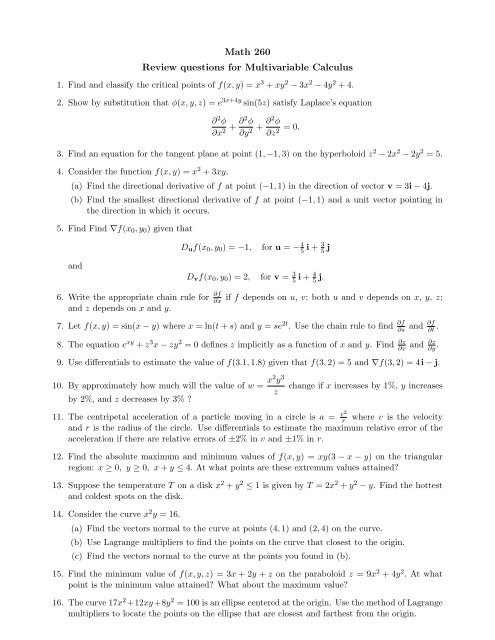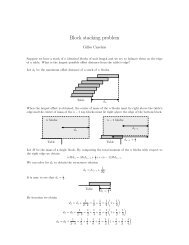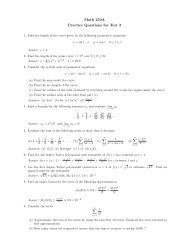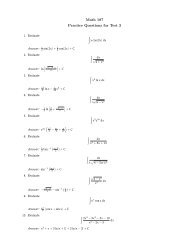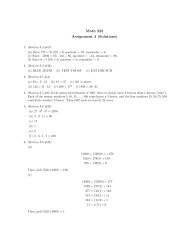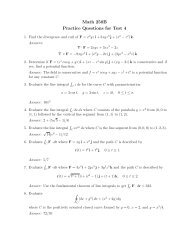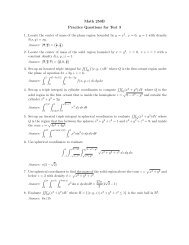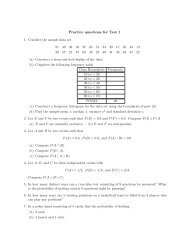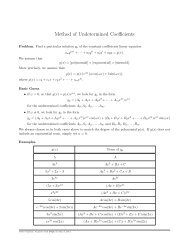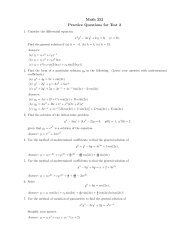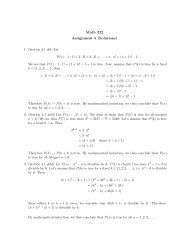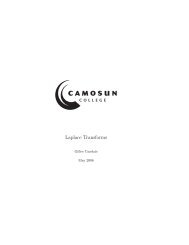Math 260 Review questions for Multivariable ... - Gilles Cazelais
Math 260 Review questions for Multivariable ... - Gilles Cazelais
Math 260 Review questions for Multivariable ... - Gilles Cazelais
You also want an ePaper? Increase the reach of your titles
YUMPU automatically turns print PDFs into web optimized ePapers that Google loves.
<strong>Math</strong> <strong>260</strong><br />
<strong>Review</strong> <strong>questions</strong> <strong>for</strong> <strong>Multivariable</strong> Calculus<br />
1. Find and classify the critical points of f(x, y) = x 3 + xy 2 − 3x 2 − 4y 2 + 4.<br />
2. Show by substitution that φ(x, y, z) = e 3x+4y sin(5z) satisfy Laplace’s equation<br />
∂ 2 φ<br />
∂x 2 + ∂2 φ<br />
∂y 2 + ∂2 φ<br />
∂z 2 = 0.<br />
3. Find an equation <strong>for</strong> the tangent plane at point (1, −1, 3) on the hyperboloid z 2 − 2x 2 − 2y 2 = 5.<br />
4. Consider the function f(x, y) = x 2 + 3xy.<br />
(a) Find the directional derivative of f at point (−1, 1) in the direction of vector v = 3i − 4j.<br />
(b) Find the smallest directional derivative of f at point (−1, 1) and a unit vector pointing in<br />
the direction in which it occurs.<br />
5. Find Find ∇f(x 0 , y 0 ) given that<br />
D u f(x 0 , y 0 ) = −1,<br />
<strong>for</strong> u = − 4 5 i + 3 5 j<br />
and<br />
D v f(x 0 , y 0 ) = 2, <strong>for</strong> v = 3 5 i + 4 5 j.<br />
6. Write the appropriate chain rule <strong>for</strong> ∂f<br />
∂x<br />
if f depends on u, v; both u and v depends on x, y, z;<br />
and z depends on x and y.<br />
7. Let f(x, y) = sin(x − y) where x = ln(t + s) and y = se 2t . Use the chain rule to find ∂f<br />
∂s<br />
8. The equation e xy + z 3 x − zy 2 = 0 defines z implicitly as a function of x and y. Find ∂z<br />
∂x<br />
and<br />
∂f<br />
∂t .<br />
and<br />
∂z<br />
∂y .<br />
9. Use differentials to estimate the value of f(3.1, 1.8) given that f(3, 2) = 5 and ∇f(3, 2) = 4i − j.<br />
10. By approximately how much will the value of w = x2 y 3<br />
by 2%, and z decreases by 3% <br />
z<br />
change if x increases by 1%, y increases<br />
11. The centripetal acceleration of a particle moving in a circle is a = v2<br />
r<br />
where v is the velocity<br />
and r is the radius of the circle. Use differentials to estimate the maximum relative error of the<br />
acceleration if there are relative errors of ±2% in v and ±1% in r.<br />
12. Find the absolute maximum and minimum values of f(x, y) = xy(3 − x − y) on the triangular<br />
region: x ≥ 0, y ≥ 0, x + y ≤ 4. At what points are these extremum values attained<br />
13. Suppose the temperature T on a disk x 2 + y 2 ≤ 1 is given by T = 2x 2 + y 2 − y. Find the hottest<br />
and coldest spots on the disk.<br />
14. Consider the curve x 2 y = 16.<br />
(a) Find the vectors normal to the curve at points (4, 1) and (2, 4) on the curve.<br />
(b) Use Lagrange multipliers to find the points on the curve that closest to the origin.<br />
(c) Find the vectors normal to the curve at the points you found in (b).<br />
15. Find the minimum value of f(x, y, z) = 3x + 2y + z on the paraboloid z = 9x 2 + 4y 2 . At what<br />
point is the minimum value attained What about the maximum value<br />
16. The curve 17x 2 +12xy+8y 2 = 100 is an ellipse centered at the origin. Use the method of Lagrange<br />
multipliers to locate the points on the ellipse that are closest and farthest from the origin.
<strong>Math</strong> <strong>260</strong> <strong>Review</strong> <strong>questions</strong> <strong>for</strong> <strong>Multivariable</strong> Calculus Page 2 of 4<br />
17. Evaluate ∫∫ R (x + y) dA where R is the region bounded by y = √ x and y = x 2 .<br />
18. Locate the center of mass of the region bounded by the graphs of y = x 2 , x = 0, y = 1 with density<br />
ρ(x, y) = xy.<br />
19. Evaluate the following double integrals.<br />
(a) I =<br />
∫ 2 ∫ 4−x 2<br />
0<br />
0<br />
xe 2y<br />
∫ 2<br />
4 − y dy dx (b) I =<br />
0<br />
∫ 1<br />
y/2<br />
sin(x 2 ) dx dy (c) I =<br />
∫ ln 2 ∫ 2<br />
0<br />
e x 1<br />
ln y<br />
20. Evaluate ∫∫ R y2 dA where R is the region between the circles x 2 + y 2 = 1 and x 2 + y 2 = 4.<br />
21. Set-up iterated double integrals in polar coordinates <strong>for</strong> the following quantities.<br />
(a) The surface area of the part of the surface z = xy that lies in the region<br />
x ≥ 0, 0 ≤ y ≤ x, x 2 + y 2 ≤ 9.<br />
(b) The moment with respect to the y-axis, (i.e., ∫∫ R<br />
x dA) of the region R defined by<br />
1 ≤ x 2 + y 2 ≤ 2, y ≥ 0, 0 ≤ x ≤ √ 3 y.<br />
dy dx.<br />
(c) The moment of inertia I y of the first-quadrant region outside the circle r = 1 and inside the<br />
cardioid r = 1 + cos θ. Assume density is constant.<br />
(d) The volume of the part of the ball x 2 + y 2 + z 2 ≤ 4 that lies in the first octant and inside the<br />
cylinder x 2 + y 2 = 2x.<br />
22. Set-up an iterated triple integral <strong>for</strong> ∫∫∫ Q x2 dV where Q is the first-octant region under the plane<br />
of equation 3x + 2y + z = 6.<br />
23. Assume that p(x, y, z) is a function that measures the air pollutant particles per cubic meters of<br />
air at any point inside BC Place stadium in Vancouver. What does<br />
∫∫∫<br />
p(x, y, z) dV<br />
represent physically<br />
(BC Place)<br />
24. Set-up an iterated triple integral in cylinder coordinates to evaluate ∫∫∫ Q x2 dV where Q is the<br />
region between the paraboloids z = 4 − x 2 − y 2 and z = x 2 + y 2 .<br />
25. Set-up an iterated triple integral in spherical coordinates to evaluate I z = ∫∫∫ Q (x2 + y 2 ) dV where<br />
Q is the region that lies between the spheres x 2 + y 2 + z 2 = 1 and x 2 + y 2 + z 2 = 9, and inside<br />
the cone z = √ 4x 2 + 4y 2 .<br />
26. Use spherical coordinates to evaluate<br />
∫ 1 ∫ √ 1−x 2<br />
−1<br />
∫ √ 2−x 2 −y 2<br />
− √ √<br />
1−x 2 x 2 +y 2<br />
√<br />
x 2 + y 2 + z 2 dz dy dx.<br />
27. Evaluate ∫∫∫ B (x2 + y 2 ) dV where B = {(x, y, z) | x 2 + y 2 + z 2 ≤ 1} is the unit ball in R 3 .<br />
28. Let R be the region bounded by the curves xy = 1, xy = 4, y = 1, and y = 2. Evaluate ∫∫ R exy dA<br />
by using an appropriate change of variables.<br />
29.<br />
∫∫<br />
Let R be the parallelogram region with vertices at (0, 0), (3, −3), (5, −2), and (2, 1). Evaluate<br />
(x + y) dA by using an appropriate change of variables.<br />
R<br />
30. Let R be the region in the first quadrant bounded by the curves xy = 1, xy = 2, y = x, and<br />
y = 3x. Evaluate ∫∫ R y2 dA by using the change of variables u = xy and v = y/x.
<strong>Math</strong> <strong>260</strong> <strong>Review</strong> <strong>questions</strong> <strong>for</strong> <strong>Multivariable</strong> Calculus Page 3 of 4<br />
Answers<br />
1. (0, 0) → relative maximum, (2, 0) → saddle point.<br />
2. We have φ xx = 9 φ, φ yy = 16 φ, and φ zz = −25 φ. Then, φ xx + φ yy + φ zz = 9φ + 16φ − 25φ = 0.<br />
3. −2x + 2y + 3z = 5.<br />
4. (a) 3 (b) Smallest D u f(−1, 1) is − √ 10 in direction u = −1 √<br />
10<br />
i + 3 √<br />
10<br />
j.<br />
5. ∇f(x 0 , y 0 ) = 2i + j = 〈2, 1〉.<br />
6.<br />
7.<br />
8.<br />
∂f<br />
∂x = ∂f ∂u<br />
∂u ∂x + ∂f ∂u ∂z<br />
∂u ∂z ∂x + ∂f ∂v<br />
∂v ∂x + ∂f ∂v ∂z<br />
∂v ∂z ∂x .<br />
∂f<br />
∂s<br />
=<br />
cos(x − y)<br />
t + s<br />
∂z<br />
∂x = −(yexy + z 3 )<br />
3z 2 x − y 2<br />
9. f(3.1, 1.8) ≈ 5.6<br />
− e 2t cos(x − y) and ∂f<br />
∂t<br />
and<br />
10. w increases by about 11%.<br />
∂z<br />
∂y = −(xexy − 2zy)<br />
3z 2 x − y 2 .<br />
=<br />
cos(x − y)<br />
t + s<br />
11. The maximum relative error of the acceleration is about 5%.<br />
− 2se 2t cos(x − y).<br />
12. Absolute maximum value is 1, attained at (1, 1). Absolute minimum value is −4, attained at<br />
(2, 2).<br />
( √ )<br />
13. Hottest spots: ± 3<br />
2 , − 1 2<br />
where T = 9/4. Coldest spot: (0, 1 2<br />
) where T = −1/4.<br />
14. (a) A vector normal at (4, 1) is i + 2j. A vector normal at (2, 4) is 4i + j.<br />
(b) The closest point to the origin are (±2 √ 2, 2).<br />
(c) A vector normal at (−2 √ 2, 2) is − √ 2 i + j. A vector normal at (2 √ 2, 2) is √ 2 i + j.<br />
15. The minimum value is − 1 2 and is attained at (x, y, z) = (− 1 6 , − 1 4 , 1 2<br />
). The function does not have<br />
a maximum value on the paraboloid.<br />
16. Closest points: (−2, −1) and (2, 1). Farthest points: (2, −4) and (−2, 4).<br />
17. 3/10<br />
18. (x, y) = ( 4<br />
7 , 3 )<br />
4<br />
19. (a) (e 8 − 1)/4, (b) 1 − cos(1), (c) 1.<br />
20.<br />
15π<br />
4<br />
21. (a) S =<br />
22.<br />
(c) I y =<br />
∫ π/4 ∫ 3<br />
0 0<br />
∫ π/2 ∫ 1+cos θ<br />
0 1<br />
∫ 2 ∫ (6−3x)/2 ∫ 6−3x−2y<br />
0<br />
0<br />
0<br />
r √ 1 + r 2 dr dθ (b) M y =<br />
r 3 cos 2 θ dr dθ (d) V =<br />
x 2 dz dy dx<br />
∫ π/2 ∫ √ 2<br />
π/6 1<br />
∫ π/2 ∫ 2 cos θ<br />
23. It represents the total amount of pollution inside BC place.<br />
0<br />
0<br />
r 2 cos θ dr dθ<br />
r √ 4 − r 2 dr dθ
<strong>Math</strong> <strong>260</strong> <strong>Review</strong> <strong>questions</strong> <strong>for</strong> <strong>Multivariable</strong> Calculus Page 4 of 4<br />
24.<br />
25.<br />
∫ 2π ∫ √ 2 ∫ 4−r 2<br />
0 0 r 2<br />
∫ 2π ∫ arctan(1/2) ∫ 3<br />
0 0<br />
1<br />
r 3 cos 2 θ dz dr dθ<br />
ρ 4 sin 3 φ dρ dφ dθ<br />
26. π(2 − √ 2)<br />
27. 8π/15<br />
28. (e 4 − e) ln 2<br />
29. We can use the change of variable u = x + y and v = x − 2y to get ∫∫ R<br />
(x + y) dA = 27/2.<br />
Note that if we use rectangular coordinates, we need to evaluate three double integrals.<br />
30. 3/2<br />
∫ 2 ∫ x/2<br />
0<br />
−x<br />
(x + y) dy dx +<br />
∫ 3 ∫ 3−x<br />
2<br />
−x<br />
(x + y) dy dx +<br />
∫ 5 ∫ 3−x<br />
3<br />
(x−9)/2<br />
(x + y) dy dx = 27<br />
2<br />
<strong>Gilles</strong> <strong>Cazelais</strong>, March 13, 2008.


